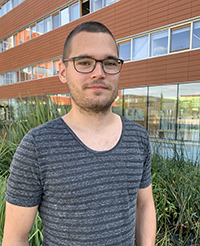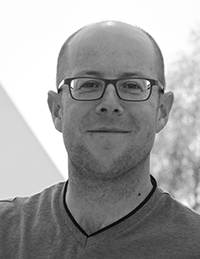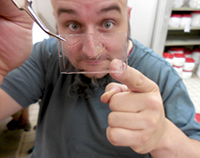 Mario Schädel. Ludwig-Maximilians-Universität München, Department of Biology II, Zoomorphology group, Großhaderner Straße 2, 82152 Planegg-Martinsried, Germany. mario.schaedel@palaeo-evo-devo.info
Mario Schädel. Ludwig-Maximilians-Universität München, Department of Biology II, Zoomorphology group, Großhaderner Straße 2, 82152 Planegg-Martinsried, Germany. mario.schaedel@palaeo-evo-devo.info
Mario Schädel is born in Bad Friedrichshall, Germany in 1992. He studied biology (Bachelor of Science) and geoecology (Master of Science) at Eberhard-Karls-Universität Tübingen. In 2017 he started his Ph.D. at Ludwig-Maximilians-Universität in Munich under the supervision of Joachim Haug. Currently, his research focus is on the systematics and palaeoecology of fossil isopods and insects.

 Vincent Perrichot. Univ. Rennes, CNRS, Géosciences Rennes, UMR 6118, 35000 Rennes, France. vincent.perrichot@univ-rennes1.fr
Vincent Perrichot. Univ. Rennes, CNRS, Géosciences Rennes, UMR 6118, 35000 Rennes, France. vincent.perrichot@univ-rennes1.fr
Vincent Perrichot is born in Brittany, France in 1976. He obtained his Ph.D. in biology at the University of Rennes in 2003, on the study of Cretaceous amber deposits from France and their corresponding forest ecosystems. He spent two years at the Natural History Museum of Berlin as a Humboldt research fellow, working with Alexander Schmidt on the paleoecology of resin-producing forests through the study of arthropods and microorganisms fossilized in amber. He then became a postdoctoral fellow at the Paleontological Institute of the University of Kansas, where he worked on the systematics, phylogeny, and biogeography of hymenopteran insects from various Mesozoic and Cenozoic ambers. In 2009 he returned to the University of Rennes as a full time assistant professor. Since then he has been studying the paleobiota and paleoenvironments of various Mesozoic and Tertiary ambers, with a particular focus on the ants, and using synchrotron imaging at the ESRF on a regular basis to visualize fossils in opaque amber. In parallel with his main research topic on the evolution of insects, he is studying modern resin-producing forests in order to understand the processes involved in the trapping of organisms by tree resins.

 Joachim T. Haug. Ludwig-Maximilians-Universität München, Department of Biology II, Zoomorphology group, Großhaderner Straße 2, 82152 Planegg-Martinsried, Germany and Ludwig-Maximilians-Universität München, GeoBio-Center, Richard-Wagner-Str. 10, 80333 München, Germany. joachim.haug@palaeo-evo-devo.info
Joachim T. Haug. Ludwig-Maximilians-Universität München, Department of Biology II, Zoomorphology group, Großhaderner Straße 2, 82152 Planegg-Martinsried, Germany and Ludwig-Maximilians-Universität München, GeoBio-Center, Richard-Wagner-Str. 10, 80333 München, Germany. joachim.haug@palaeo-evo-devo.info
Joachim T. Haug studied animal ecology (major), sociobiology and palaeontology (minors) at the Julius-Maximilians-Universität Würzburg. After the receipt of the Diplom in 2005, he moved to the work group Biosystematic Documentation at the University of Ulm for his PhD thesis. There he worked on the early crustaceans from the Cambrian 'Orsten', which are preserved three-dimensionally and with minute details. To make the entire morphology clearly visible, Joachim produced computer-based 3D models for each developmental stage of a species, resulting in a 4D model of the species. With 4D models reconstructed for the different species, differences in the developmental pattern between the species became visible. These changes in the developmental timing, so-called heterochronic events must have occurred several times during early crustacean evolution. Due to these findings, Joachim got interested in studying such evolutionary changes of development also in fossils from other deposits and focussed on Palaeo-Evo-Devo (see also http://www.palaeo-evo-devo.info). After his defense in 2009 and two further years as postdoctoral researcher in Ulm, he received two Feodor Lynen research fellowships from the Alexander von Humboldt-Foundation, with which he was doing research at Yale University and at the Ernst-Moritz-Arndt-Universität Greifswald. Besides 3D modelling, Joachim is also interested in different methods of imaging (documentation and presentation). In September 2013, he relocated to the Ludwig-Maximilians-Universität in Munich. In April 2018 Joachim became a Lichtenberg professor at the Ludwig-Maximilians-Universität München (LMU Munich) funded by the Volkswagen Foundation.

